|
"UNAM" redirects here. For other uses, see UNAM (disambiguation).
|
|
This article has multiple issues. Please help improve the article or discuss these issues on the talk page.
- It needs additional references or sources for verification. Tagged since September 2008.
- It is in a list format that may be better presented using prose. Tagged since September 2008.
- Its quality may be compromised by peacock terms. Tagged since September 2008.
- It may need copy editing for grammar, style, cohesion, tone or spelling. Tagged since September 2008.
|
| Universidad Nacional Autónoma de México |
| National Autonomous University of Mexico |

Official seal |
| 校训 |
Por mi raza hablará el espíritu |
| 英语校训 |
The spirit shall speak for my race. |
| 建立于 |
September 22, 1910 |
| 类型 |
Public university |
| 校长 |
José Narro Robles |
| 工作人员 |
34,835 |
| 学生 |
305,969 (2008-2009) |
| 本科生 |
172,444 (2009) |
| 研究生 |
23,875 (2009) |
| 位置 |
Mexico City,  Mexico Mexico
19°19′44″N 99°11′14″W / 19.32889°N 99.18722°W / 19.32889; -99.18722Coordinates: 19°19′44″N 99°11′14″W / 19.32889°N 99.18722°W / 19.32889; -99.18722 |
| 校园 |
Urban, 7.3 km (2.8 sq mi), main campus only |
| 颜色 |
Blue & Gold |
| Mascot |
Puma |
| 体育运动 |
41 varsity teams |
| 网址 |
www.unam.mx |
The National Autonomous University of Mexico (Spanish: Universidad Nacional Autónoma de México) (UNAM) is a public university based primarily in Mexico City and generally considered to be the largest one-campus university in the Americas in terms of student population. Founded on 22 September 1910 by Justo Sierra as a liberal alternative to the Roman Catholic-sponsored Royal and Pontifical University of Mexico (founded on September 21, 1551 by a royal decree of Charles I of Spain and brought to a definitive closure in 1867 by the liberals), it is the only university in Mexico with Nobel Prize laureates among its alumni: Alfonso García Robles (Peace), Octavio Paz (Literature), and Mario Molina (Chemistry).
It also generates a number of different publications in diverse areas, such as mathematics, physics and history.
UNAM's autonomy, granted in the 1920s, has given it the freedom to define its own curriculum and manage its own budget without interference from the government. This has had a profound effect on academic life at the university, which some claim it boasts academic freedom and independence.
Besides being one of the most recognized universities in Latin America, it is one of the largest and the most artistically detailed. Its main campus is a World Heritage site that was designed by some of Mexico's best-known architects of the 20th century. Murals in the main campus were painted by some of the most recognized artists in Mexican history, such as Diego Rivera and David Alfaro Siqueiros.
历史
The university was founded on 22 September 1910 by Justo Sierra, then Minister of Education in the Porfirio Díaz' regime, who sought to create a very different institution from its 19th century precursor; the Royal and Pontifical University of Mexico, which had been founded on 21 September 1551 by a royal decree signed by Crown Prince Phillip on behalf of Charles I of Spain and brought to a definitive closure in 1867 by Benito Juárez and his fellow Liberals. Instead of reviving what he saw as an anachronistic institution with strong ties to the Roman Catholic Church, he aimed to create a new university, secular in nature and national in scope, that may reorganize higher education within the country, serve as a model of positivism and encompass the ideas of the dominant Mexican liberalism.
The project initially unified the Fine Arts, Business, Political Science, Jurisprudence, Engineering, Medicine, Normal and the National Preparatory schools, and had Joaquin Eguía y Lis as its first rector.
The new university’s challenges were mostly political, with some resisting the establishment of the institution on philosophical grounds, but the main challenges came from the ongoing Mexican Revolution and the fact that the federal government had direct control over the university’s policies and curriculum. This led to disruptions in the function of the university when political instability forced resignations in the government, including that of President Díaz. Internally, the first student strike occurred in 1912 to protest examination methods introduced by director of the School of Jurisprudence, Luis Cabrera. By July of that year, a majority of the law students decided to abandon the university and join the newly-created Free School of Law.
In 1914, initial efforts to gain autonomy for the university were undertaken without success. In 1920, José Vasconcelos became rector. In 1921, he created the school’s coat-of-arms: the image of an eagle and a condor surrounding a map of 拉丁语 America, from Mexico's northern border to Tierra del Fuego and the motto, "The Spirit shall speak for my race." Efforts to gain autonomy for the university continued in the early 1920s. In the mid-1920s, a second wave of student strikes was held when the university decided to impose a new grading system. This led to major classroom walkouts in the law school and confrontation with police at the medical school. The striking students were supported by many of the professors and subsequent negotiations eventually led to autonomy for the university. The institution was no longer a dependency of the Secretariat of Public Education; the university rector became the final authority, eliminating much of the duplicity in authority that had existed earlier.
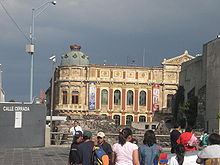
Palacio de la Autonomía, located off Moneda Street east of the Zocalo.
Initial decisions to move the university from the various buildings it occupied in the city center to a new and consolidated university campus were taken in 1943, and to place this new Ciudad Universitaria (lit. University City) in San Ángel, to the south of the city. The first stone of the faculty of Sciences, the first building of Ciudad Universitaria, was laid. President Miguel Alemán Valdés participated in the ceremony on 20 November 1952. The University Olympic Stadium was inaugurated on the same day. In 1957, the Doctorate Council was created to regulate and organize graduate studies.
Another major student strike, again over examination regulations, occurred in 1966. Students invaded the rectorate and forced the rector to resign. The Board of Regents did not accept this resignation. Then the professors went on strike, paralyzing the university and the resignation was accepted. In the summer, outbreaks of violence occurred on a number of the campuses of the University-affiliated preparatory schools, prompted harsh police reaction. Police took over a number of high school campuses, with injuries. On the main campus during August 1968, protests formed against the police actions in its main campues and in the center of the city. The protests grew into a student movement which demanded the resignation of the police chief among other things. More protests followed in September, gaining frequency and protestors. During a meeting of the student leaders, the army fired on the Chihuahua building in Tlatelolco where the student organization supposedly was. They also fired on the crowd that was outside, with many dead, wounded and detained. Protests continued after that. Only ten days after, the 1968 Olympic Games were inaugurated at the University Stadium. The games shut the University down for the duration. After that, there was some progress to bringing things back to normal.
The 1970s and 1980s are mostly marked by the opening of satellite campuses in other parts of Mexico and nearby areas, to decentralize the system. There were some minor student strikes, mostly over grading and tuition. The last major student strike at the university occurred in 1999-2000 when students shut down the campus for almost a year to protest a proposal to charge students the equivalent of $150 USD per semester for those who could afford it. The strike lasted for almost a year, with the campus being empty much of that time. Referendums were held by both the university and the strikers but neither side accepted the others’ results. Acting on a judge’s order, the police stormed the buildings held by strikers on 7 February 2000, putting an end to the strike..
In 2009 the university was bestowed with the Prince of Asturias Award for Communication and Humanities and began the celebration of its centennial with several activities that will last until 2011.
Campuses
University City
Main article: Ciudad Universitaria
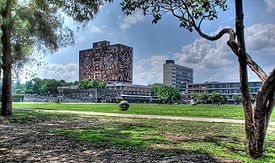
The main campus in Mexico City.
"Ciudad Universitaria" (University City) is UNAM's main campus, located within Coyoacán borough in the southern part of Mexico City. Designed by architects Mario Pani, Enrique del Moral, Domingo García Ramos, Armando Franco Rovira and others, it encloses the Estadio Olímpico Universitario, about 40 faculties and institutes, the Cultural Center, an ecological reserve, the Central Library, and a few museums. It was built during the 1950s on an ancient solidified lava bed to replace the scattered buildings in downtown Mexico City where classes were given. It was completed in 1954 and is almost a separate region within Mexico City, with its own regulations, councils, and police (to some extent) in a more fundamental way than most universities around the world. Law enforcement officials from outside the university are not allowed to enter without the consent of the university authorities.
In June 2007, its main campus, Ciudad Universitaria, was declared a UNESCO World Heritage Site.
Satellite campuses
Apart from Ciudad Universitaria, UNAM has several campuses in the Metropolitan Area of Mexico City (Acatlán, Aragón, Cuautitlán, Iztacala, Xochimilco and Zaragoza), as well as many others in several locations across Mexico (in Santiago de Querétaro, Morelia, Mérida, Ensenada, and Cuernavaca), mainly aimed at research and graduate studies. It has also four small foreign campuses in the United States and Canada, focusing on Spanish language and Mexico's culture:UNAM San Antonio, TX; Chicago, Illinois; Los Angeles, California; Gatineau, Quebec.
External buildings of interest
Palacio de Minería
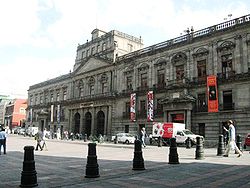
Colegio de Minería (College of Mining) building on Tacuba street in the historic center of Mexico City.
Under the care of UNAM's Engineering Faculty, the Colonial Palace of Mining is located in the historical center of Mexico City. Formerly the School of Engineering, it has three floors, and houses the International Book Expo ("Feria Internacional del Libro" or "FIL") and the International Day of Computing Security Congress ("DISC"), among regular events. It also has a permanent exhibition of historical books, mostly topographical and naturalist works of 19th century Mexican scientists, in the former library of the School of Engineers. It has also several exhibitions related to mining, the prime engineering occupation during the Spanish colonization. It is considered to be one of the most significant of Mexican architecture of its period.
Casa del Lago
House of the Lake, in Chapultepec Park, is a place devoted to cultural activities including dancing, theatre plays and ballet. It also serves as meeting place for university-related organizations and committees.
Museum of San Ildefonso
Main article: San Ildefonso College
This museum and cultural center considered to be the birthplace of the Mexican muralism movement. San Ildefonso began as a prestigious Jesuit boarding school, and after the Reform War, it gained educational prestige again as National Preparatory School, which was closely linked to the founding of UNAM. This school and the building closed completely in 1978, then reopened as a museum and cultural center in 1994 administer jointly by UNAM, the National Council for Culture and Arts and the government of the Federal District of Mexico City. The museum has permanent and temporary art and archeological exhibitions in addition to the many murals painted on its walls by Jose Clemente Orozco, Diego Rivera and others. The complex is located between San Ildefonso Street and Justo Sierra Street in the historic center of Mexico City .
Chopo University Museum
Possessing an artistic architecture, large crystal panels and two iron towers designed by Gustave Eiffel; it served the National Museum of Natural History for almost 50 years. It is now devoted to the temporary exhibitions of visual arts. The Chopo Museum was begun with part of the collection of the now-defunct Public Museum of Natural History, Archeology and History, which eventually became the National Museum of Cultures.
National Astronomical Observatory
Main article: National Astronomical Observatory (Mexico)
The National Astronomical Observatory is located in the Sierra San Pedro Mártir mountain range in Baja California, about 130 kilometers south of United States-Mexican border. It has been in operation since 1970 and it currently boasts three large reflecting telescopes, with plans for installing a large instrument sensitive to milimetric wavelengths already under way.
组织
It consists of faculties rather than departments. Both undergraduate and graduate studies are available. UNAM is also responsible for the Escuela Nacional Preparatoria (ENP) (National Preparatory School), and the Colegio de Ciencias y Humanidades (CCH) (Science and Humanities College), which consist of several high schools, spread around Mexico City. Counting ENEP, CCH, FES (Facultad de Estudios Profesionales) undergraduate and graduate students, UNAM has over 269,000 students, making it one of the world's largest universities.
Faculties and National Schools
UNAM recognizes two different types of university schools: Faculties and National Schools. Faculties are the only institutions that have postgraduate studies. Currently, most of the schools, either inside or outside the University City, had this title. A National School is an institution that cannot offer all postgraduate studies (Master's degrees and Doctorates). This is the case of the National School of Music, the National School of Arts, the National School of Nursery and Obstetrics, and the National School of Social Work.
List of Faculties, National Schools and Institutes
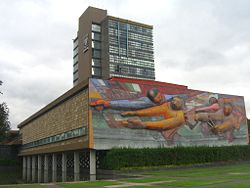
Mural by David Alfaro Siqueiros
- Faculty of Accounting and Administration
- Faculty of Architecture
- Faculty of Chemistry
- Faculty of Economics
- Faculty of Engineering
- Faculty of Higher Studies (FES) Aragón
- Faculty of Higher Studies (FES) Acatlán
- Faculty of Higher Studies (FES) Cuautitlán
- Faculty of Higher Studies (FES) Iztacala
- Faculty of Higher Studies (FES) Zaragoza
- Faculty of Law
- Faculty of Medicine
- Faculty of Odontology
- Faculty of Philosophy and Literature
- Faculty of Political and Social Sciences
- Faculty of Psychology
- Faculty of Sciences
- Faculty of Veterinarian Medicine
- National School of Arts
- National School of Music
- National School of Nursery and Obstetrics
- National School of Social Work
- National Preparatory School (with 9 high schools)
- College of Sciences and Humanities (with 5 high schools)
- Institute of Aesthetic Research
- Center for Genomic Sciences (CCG)
学术
Rankings
According to 2009 THES - QS World University Rankings, the University is the 190th best ranked university in the world and the second best in Ibero-America after the University of Barcelona. According to the 2008 Academic Ranking of World Universities developed by the Institute of Higher Education of the Shanghai Jiao Tong University, UNAM is ranked in the 152-200 tier and holds the 2nd place among Ibero-American universities in a tie between the University of Buenos Aires and the University of Barcelona but below the University of Sao Paulo (101-151 tier).
Research
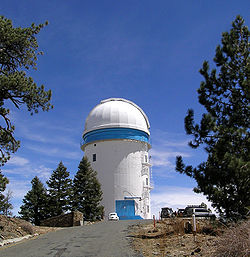
The university's San Pedro Mártir Observatory in Baja California.
UNAM has excelled in many areas of research and houses many of Mexico's premiere research institutions. In recent years it has attracted students and hired professional scientists from all over the world (most notably from Russia, India and the United States), which has created a unique diverse scientific community.
Scientific research at UNAM is divided between faculties, institutes, centers and schools, and covers a range of disciplines in 拉丁语 America. Some of the more noted institutes include: Institute of Astronomy, Institute of Biotechnology, Institute of Nuclear Sciences, Institute of Ecology, Institute of Physics, Institute of Cell Physiology, Institute of Geophysics, Institute of Engineering, Institute of Materials Research, Institute of Chemistry, Institute of Biomedical Sciences, and the Applied Mathematics and Systems Research Institute.
Research centers tend to focus on multidisciplinary problems particularly relevant to Mexico and the developing world, most notably: Center of Applied Sciences and Technological Development, which focuses on connecting the sciences to real-world problems (e.g., optics, nanosciences) and Center of Energy Research, which does world-class research in alternative energies.
All research centers are open to students from Mexico and around the world. The UNAM holds a number of programs for students within the country to make scientific internships in order to impulse research in the country.
UNAM's scientific output continues to grow, despite numerous attempts by the Mexican government to curtail its budget, the University currently producing 60% of all scientific publications in Mexico.
As for basic sciences, UNAM currently has two Howard Hughes Medical Institute Scholars and endowment from the NIH extramural research program.
Students and faculty
Sports, clubs, and traditions
|
|
It has been suggested that Pumas Dorados de la UNAM be merged into this article or section. (Discuss) |
Professional football team
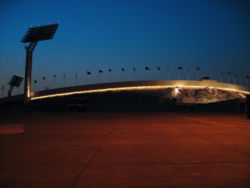
A view of UNAM's Olympic Stadium
UNAM's football team Club Universidad Nacional participates in the Primera División de México of the Mexican Football League Division. The club became two-time consecutive champions of the Apertura, and the Clausura in 2004. Their home ground is the Estadio Olímpico Universitario stadium.
The University, has as a yearly tradition to make a large display of Ofrendas all over the main square of Ciudad Universitaria, each school builds an ofrenda, and in the center there is usually a biggest one that has a different theme each year, depending on the festivities of the University that year.
Political activism
UNAM students and professors are regarded throughout Mexico as very politically aware and sometimes intensely politically active. While most of its students usually adhere to left-wing political ideologies and movements, the University has also been the alma mater of a number of prominent right-wing and neo-liberal politicians such as Carlos Salinas de Gortari and Manuel Gómez Morín.
Student associations
The UNAM is made up of several associations of current students and alumni that provide extra-curricular activities to the whole community, enriching the University's activities with cultural, social and scientific events.
- Fundacion UNAM
- Nibiru Sociedad Astronomica
- SAFIR
Alleged links between UNAM and FARC
- See also Faculty of Philosophy and Literature links with FARC
On June 2003 former Colombian ambassador in Mexico Luis Guzmán said that there were FARC offices on the UNAM Faculty of Philosophy and Literature and these offices were making propaganda and recruiting people to participate on the guerrilla. [1]
Noted alumni
- See also Category:National Autonomous University of Mexico alumni
Many of the most prominent figures in the economical, political, scientific and artistic life in Mexico have been a member of the UNAM alumni or faculty:
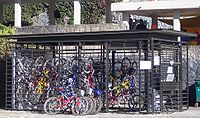
A bicycle jail at the Faculty of Philosophy and Letters.
Heads of state
- Miguel Alemán Valdés (President of Mexico 1946–1952)
- Miguel de la Madrid Hurtado (President of Mexico 1982–1988)
- Luis Echeverría Álvarez (President of Mexico 1970–1976)
- José López Portillo y Pacheco (President of Mexico 1976–1982)
- Abel Pacheco de la Espriella (President of Costa Rica 2002–2006)
- Alfonso Portillo (President of Guatemala 2000–2004)
- Carlos Salinas de Gortari (President of Mexico 1988–1994)
Politicians
- Antonio Carrillo Flores (cabinet minister in several previous administrations, 1929, 1950)
- Alfonso Caso y Andrade (a very noted archaeologist)
- Alan Cranston (U.S. Senator from California)
- Álvaro García Linera (vice-president of Bolivia)
- Andrés Manuel López Obrador (Head of Government of the Federal District from 2000 to 2005, candidate for the Presidency of Mexico in 2006)
- Abel Pacheco (president of Costa Rica)
- Alfonso Portillo (president of Guatemala)
- Veton Surroi (Kosovo publicist and leader of the Kosovar Party ORA)
Diplomats
- Narciso Bassols (former ambassador to Russia, France, and Great Britain; former director of UNAM's School of Law)
- Antonio Carrillo Flores (Ministry of Mexican Foreign Affairs during the Díaz Ordaz administration)
- Alfonso García Robles (a Nobel Peace Prize laureate)
- Antonio Gómez Robledo (Ministry of Mexican Foreign Affairs during the López Portillo administration)
- Rosario Green (Ministry of Mexican Foreign Affairs during the Zedillo administration)
Artists, writers and humanists
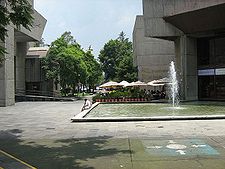
University cultural center
- William F. Buckley, writer and political philosopher; attended in 1943 prior to being commissioned in the US Army during the World War II.
- Alfonso Caso, archaeologist.
- Fernando del Paso, writer.
- Salvador Elizondo, writer and a member of El Colegio Nacional.
- Bolívar Echeverría, ecuadorian writer and philosopher.
- Carlos Fuentes, writer, essayist and a member of El Colegio Nacional
- Alfonso García Robles, a Peace Nobel Prize laureate.
- Enrique Krauze, historian, essayist and publisher (director of Letras Libres journal).
- Agustín Landa Verdugo, architect and urban planner.
- Audre Lorde, writer, poet and activist.
- Horst Matthai Quelle, philosopher
- Carlos Monsiváis, editorialist and writer.
- José Emilio Pacheco, writer and a member of El Colegio Nacional.
- Eduardo Pareyón Moreno, archaeologist.
- Octavio Paz, poet and essayist; a Literature Nobel Prize laureate (he never graduated).
- Elena Poniatowska, journalist and writer.
- Alfonso Reyes, writer, philosopher and diplomat.
- Alejandro Rossi, philosopher and writer.
- Jaime Sabines, poet.
- Adolfo Sánchez Vázquez, philosopher and writer.
- Enrique Semo, historian, writer, activist, Mexico City Secretary of Culture
- Jaime Torres Bodet, writer and politician.
- Ayako Tsuru,Mural Artist.
- Jorge Volpi, novelist and essayist; current director of Canal 22 in Mexican free television.
- Jacobo Zabludovsky, lawyer, journalist and first TV Anchorman in Mexico.
- Juan García Esquivel, musician
Physicians and surgeons
- Carlos Fernández del Castillo, M.D. (a specialist in pancreatic diseases, pancreatobiliary surgery, gastrointestinal surgery) (Massachusetts General Hospital, USA) [2]
- Guillermo Soberón Acevedo (biochemist and a member of El Colegio Nacional)
Scientists
- Miguel Alcubierre, theoretical and computational physicist (see Alcubierre metric).
- Nabor Carrillo Flores, a soil mechanics expert, a nuclear energy advisor and former president of UNAM.
- Miguel de Icaza, free software programmer (dropped out).
- Carlos Frenk, astronomer, a pioneer in simulations of large-scale structures.
- Guillermo Haro, astronomer, co-discoverer of Herbig–Haro objects.
- Jerzy Rzedowski, plant scientist; he was a pioneer in the field of Neotropical florsitics
- Antonio Lazcano, a notable biologist working in the field of origin of life; a current member of the group of scientists working to understand and fight against the A/H1N1 virus.
- Luis E. Miramontes, co-inventor of the contraceptive pill.
- Mario J. Molina, a Chemistry Nobel Prize laureate.
- Marcos Moshinsky, a theoretical physicist.
- Rodolfo Neri Vela, the first Mexican in space.
- Víctor Neumann-Lara, a pioneer in graph theory in Mexico.
- Ruy Pérez Tamayo, a pathologist and a member of El Colegio Nacional.
- Constantino Reyes-Valerio, chemist and historian who coined the term arte indocristiano and contributed to the discovery of the production of Maya blue pigment.
- Miguel José Yacamán, physicist.
- Salvador Zubirán, a physician, founder of the National Institute of Nutrition.
- Santiago Lopez de Medrano.Mathematician of the Institute of Mathematics,UNAM
Businesspeople
- Gilberto Borja Navarrete, engineer, founder of Grupo ICA, one of the main national and international building companies.
- Carlos Slim Helú, businessman and engineer and the richest person in the world.
Sports stars
- Hugo Sánchez Márquez, one of Mexico's most acknowledged football players. Former Mexian National football team and Almeria manager.
- María Eugenia "Cuca" Huerta, one of Mexico's top female football flag players and multiple champion at local and international leagues.
Noted faculty
- See also Category:National Autonomous University of Mexico faculty
- Jorge González Reyna, architect.
- Max Cetto, architect.
- Alejandro Corichi, astrophysicist.
- Axel Didriksson Takanayagui, a writer education researcher and current Secretary of Education working for the Government of Mexico City.
- Erich Fromm, a German-born philosopher and psychoanalist, founder of the Mexican Institute of Psychoanalysis.
- José Gaos, philosopher.
- es:Pablo González Casanova, sociologist and former president of the UNAM.
- Jorge González Torres, politician, former presidential candidate.
- Paul Kirchhoff, anthropologist and ethnohistorian, one of the founders of anthropological studies at UNAM.
- José Miguel Insulza, a Chilean politician, secretary of the Organization of American States.
- Larry Laudan, philosopher
- Miguel León-Portilla, historian and náhuatl language researcher.
- Florian Luca, mathematician
- Rodolfo Neri Vela, the first Mexican astronaut to go into space.
- Edmundo O'Gorman, historian and writer.
- Imanol Ordorika, a specialist in education.
- Kiyoto Ota, sculptor.
- Arturo Rosenblueth, physiologist.
- Adolfo Sánchez Vázquez, a Spanish-born philosopher.
- Manuel Sandoval Vallarta, physicist and cosmic ray researcher.
- Sara Sefchovich, writer.
UNAM's Philharmonic Orchestra (OFUNAM)
更多
- XHUNAM-TV ("TVunam", UNAM's educational and cultural television channel)
- DGSCA (Dirección General de Servicios de Cómputo Académico, Hub of Computer Sciences/Engineering in UNAM)
参考文献
- ^ Universidad Nacional Autónoma de México. "UNAM Through Time". http://www.unam.mx/EN/aboutunam/unam_tiempo/unam/1910.html. "Later, on April 26, [1910] he set the National University's founding project in motion. The new institution would be composed of the National Preparatory High School and the School of Higher Studies, along with the schools of Jurisprudence, Medicine, Engineering and Arts (Architecture). The project was approved and the National University of Mexico was solemnly inaugurated on September 22. The universities of Salamanca, Paris and Berkeley were its 'godmothers'."
- ^ Justo Sierra (1910-09-22). "Discurso en el acto de la inauguración de la Universidad Nacional de México, el 22 de septiembre de 1910" (in Spanish) (PDF). http://www.ses.unam.mx/docencia/Lectura1.pdf. "¿Tenemos una historia? No. La Universidad mexicana que nace hoy no tiene árbol genealógico"
- ^ Annick Lempérière. "Los dos centenarios de la Independencia mexicana (1910-1921): de la historia patria a la antropología cultural" (in Spanish) (PDF). University of Paris I. http://historiamexicana.colmex.mx/pdf/13/art_13_1937_16329.pdf. "La universidad soñada por Justo Sierra, ministro de Instrucción Pública, última creación duradera del régimen porfirista, se inauguró al mismo tiempo que la Escuela Nacional de Altos Estudios, que debía ceder su lugar a las humanidades, junto a los programas científicos de los cursos porfiristas. El discurso inaugural de Sierra iba a tono con el espíritu de las celebraciones. La universidad naciente no tenía nada en común, insistía, con la que la precedió: no tenía 'antecesores', sino 'precursores'."
- ^ Javier Garciadiego. "De Justo Sierra a Vasconcelos. La Universidad Nacional durante la Revolución Mexicana" (in Spanish) (PDF). El Colegio de México. http://historiamexicana.colmex.mx/pdf/13/art_13_1866_16697.pdf. "El mayor esfuerzo en la vida de Sierra fue, precisamente, revertir tal postura; así, se afanó obsesivamente en crear una universidad de ese tipo, pues era la institución que mejor encabezaba "los esfuerzos colectivos de la sociedad moderna para emanciparse integralmente del espíritu viejo". Al margen de numerosas diferencias sustanciales con los liberales, los positivistas, que dominaron el sistema nacional de instrucción pública superior desde 1865, también eran contrarios al establecimiento de una universidad, tanto por conveniencias políticas como por principios doctrinales. Esto hace más admirable el esfuerzo de don Justo, pues era un miembro destacado —canonizado, dice O'Gorman— del grupo de positivistas mexicanos. Su lucha no fue sólo pedagógica sino también política. Si bien no se puede coincidir con [Edmundo] O'Gorman respecto al carácter de Sierra como jerarca del positivismo mexicano, pues siempre fue cuestionado por los más ortodoxos como un pensador ecléctico, falto de disciplina, es de compartirse la admiración que profesa a don Justo, pues su lucha por la fundación de la Universidad Nacional implicó serios distanciamientos de sus principales compañeros políticos e intelectuales, ya fueran liberales o positivistas."
- ^ Manuel López de la Parra. "La casi centenaria UNAM" (in Spanish). http://www.informador.com.mx/editorial/2008/28260/6/la-casi-centenaria-unam.htm. ""Ciertamente no ha transcendido el hecho de que la Universidad Nacional Autónoma de México; autónoma desde 1929, está próxima a cumplir su primer centenario de vida académica, pues fue inaugurada el 22 de septiembre de 1910, en ocasión de los festejos del primer centenario del inicio de la Revolución de Independencia durante los últimos tiempos del Gobierno de don Porfirio Díaz, y con base en un proyecto elaborado por don Justo Sierra, por entonces, secretario de Instrucción Pública y Bellas Artes con la participación técnica de don Ezequiel A. Chávez, de acuerdo con el modelo típico de las universidades europeas, precisamente con mucho de la Universidad de París; por ese entonces la influencia europea estaba presente, y en especial, la cultura francesa."
- ^ Marissa Rivera. "Arrancan festejos por los 100 años de la UNAM" (in Spanish). http://www2.esmas.com/noticierostelevisa/mexico/026654/arrancan-festejos-100-aos-unam. "El rector José Narro anuncia el programa de actividades para conmemorar los 100 años de UNAM, que iniciaron este miércoles y concluirán el 22 de septiembre de 2011."
- ^ La UNAM en numeros (2008-2009)
- ^ http://www.deportes.unam.mx/?option=com_content&task=view&id=17&Itemid=38
- ^ Preston, Julia (2000-01-20). "University, Mexico's Pride, Is Ravaged by Strike". http://query.nytimes.com/gst/fullpage.html?res=950CE1DE153DF933A15752C0A9669C8B63.
- ^ Javier Garciadiego. "De Justo Sierra a Vasconcelos. La Universidad Nacional durante la Revolución Mexicana" (in Spanish) (PDF). http://historiamexicana.colmex.mx/pdf/13/art_13_1866_16697.pdf. "Durante el siglo XIX los gobiernos liberales consideraron una "obligada muestra" de sus convicciones suprimir la Universidad, heredera de la Nacional y Pontificia, como para los conservadores reinstalarla era signo de lealtad a sus principios."
- ^ Elizalde,Guadalupe, Piedras en el Camino de la UNAM, EDAMEX, 1999 p.49.
- ^ Méndez Arceo, Sergio (1990) (in Spanish). La Real y Pontificia Universidad de México: antecedentes, tramitación y despacho de las reales cédulas de erección. Mexico City: Universidad Nacional Autónoma de México. pp. 93–100. ISBN 9683617042. OCLC 25290441.
- ^ Justo Sierra. "Discurso en el acto de la inauguración de la Universidad Nacional de México, el 22 de septiembre de 1910" (in Spanish) (PDF). Universidad Nacional Autónoma de México. http://www.ses.unam.mx/docencia/Lectura1.pdf.
- ^ "UNAM through time – 1960". http://www.unam.mx/acercaunam/unam_tiempo/unam/antecedentes.html. Retrieved 2009-10-18.
- ^ "UNAM through time – 1910". http://www.unam.mx/EN/aboutunam/unam_tiempo/unam/1910.html. Retrieved 2009-10-18.
- ^ "UNAM through time – 1920". http://www.unam.mx/EN/aboutunam/unam_tiempo/unam/1920.html. Retrieved 2009-10-18.
- ^ "UNAM through time – 1940". http://www.unam.mx/EN/aboutunam/unam_tiempo/unam/1940.html. Retrieved 2009-10-18.
- ^ "UNAM through time – 1950". http://www.unam.mx/EN/aboutunam/unam_tiempo/unam/1950.html. Retrieved 2009-10-18.
- ^ "UNAM through time – 1960". http://www.unam.mx/EN/aboutunam/unam_tiempo/unam/1960.html. Retrieved 2009-10-18.
- ^ "UNAM through time – 1970". http://www.unam.mx/EN/aboutunam/unam_tiempo/unam/1970.html. Retrieved 2009-10-18.
- ^ "UNAM through time – 1980". http://www.unam.mx/EN/aboutunam/unam_tiempo/unam/1980.html. Retrieved 2009-10-18.
- ^ Preston, Julia (1999)University Officials Yield to Student Strike in Mexico June 8. Retrieved on February 14, 2006 from The New York Times site
- ^ Preston, Julia (2000) Big Majority Votes to End Strike at Mexican University January 21, 2000. Retrieved on February 14, 2006 from The New York Times site
- ^ Mexican police storm university February 7, 2000. Retrieved on February 14, 2006 from the BBC site
- ^ "The National Autonomous University of Mexico, Prince of Asturias Award Laureate for Communication and Humanities". Oviedo: Prince of Asturias Foundation. 2009-06-10. http://fundacionprincipedeasturias.org/en/press/news/mexico-university-prince-of-asturias-award-laureate-for-communication-and-humanities/. Retrieved 2009-10-19.
- ^ "UNAM celebra desde ahora su centenario [UNAM now celebrates its centennial]" (in Spanish). Milenio online (Mexico City: Milenio). 2009-10-16. http://impreso.milenio.com/node/8657952. Retrieved 2009-10-16.
- ^ UNESCO
- ^ Galindo, Carmen; Magdelena Galindo (2002). Mexico City Historic Center. Mexico City: Ediciones Nueva Guia. pp. 86–91. ISBN 968 5437 29 7.
- ^ Horz de Via (ed), Elena (1991). Guia Oficial Centro de la Ciudad d Mexico. Mexico City: INAH-SALVAT. pp. 46–50. ISBN 968 32 0540 2.
- ^ "San Ildefonso en el tiempo". http://www.sanildefonso.org.mx/frame.php?sec=11. Retrieved 2009-04-24.
- ^ Bueno de Ariztegui (ed), Patricia (1984). Guia Turistica de Mexico Distrito Federal Centro 3. Mexico City: Promexa. pp. 80–84. ISBN 968 34 0319 0.
- ^ "Museo Nacional de las Culturas, En la Ciudad de Mexico, Una ventana al Mundo" (in Spanish). http://dti.inah.gob.mx/index.php?Itemid=49&id=171&option=com_content&task=view. Retrieved 2009-03-26.
- ^ The Times - Quacquarelli Symonds (2009). "THES - QS World University Rankings 2009 - Top 200 Universities". http://www.topuniversities.com/university-rankings/world-university-rankings. Retrieved 2009-10-07.
- ^ Institute of Higher Education (2008-08-15). "Top 500 World Universities (101-200)". Shanghai Jiao Tong University. http://www.arwu.org/rank2008/ARWU2008_TopAmer(EN).htm. Retrieved 2008-09-24.
- ^ Noticias - En Día de Muertos en la UNAM imponen récord; decenas de calles del DF tienen nombres alusivos a La Catrina
- ^ http://www.colegionacional.org.mx/SACSCMS/XStatic/colegionacional/template/content.aspx?mi=160&se=vida&te=detallemiembro
- ^ http://www.eleccionesenmexico.com/archivos/noticias/el_licendiado_lopez_obrador.php
- ^ http://www.forbes.com/lists/2010/10/billionaires-2010_Carlos-Slim-Helu-family_WYDJ.html
External links
 |
Wikimedia Commons has media related to: National Autonomous University of Mexico |
- Official website
- Mexico Diplomat
- News in Spanish about UNAM
|
|



